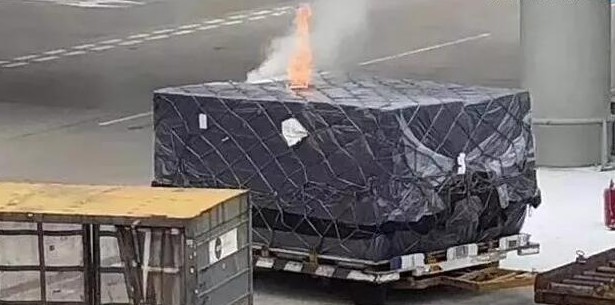Small battery charging treasure, false report, high risk
- Author:Rita
- Source:Sunny Worldwide
- Release Date:2019-01-11
According to Weiyun.com, at 2 pm on January 8th, a fire broke out on the apron of Hong Kong International Airport. On the tarmac, a wooden pallet suspected of carrying lithium batteries about 2 meters by 2 meters suddenly caught fire. Smoke, the airport fire arrived at the scene about 4 minutes after receiving the report, and the fire was saved after about 25 minutes. After the event, the airline will blacklist the shipper involved and no longer receive all the goods from this shipper. The cause of the fire is under investigation.


Electronic products such as charging treasures and walkie-talkies are also common cargoes for seaborne exports. Once the accidents are reported, the impact is huge.
How much is the lithium battery?
Lithium or lithium batteries are classified as Class 9 dangerous goods and their hazard depends on the lithium contained.
Risk:
1 Lithium battery can catch fire when it is short-circuited, overcharged, extreme temperature, wrong operation or other error conditions;
2 Whether it is due to internal causes or external heating or physical impact, it generates enough heat to cause thermal runaway of adjacent batteries. The electrolyte released by the lithium metal battery mixes the molten lithium metal with a large pressure pulse. Flammable electrolytes and molten lithium metal can produce explosive mixtures.
How much is the lithium battery?
Lithium or lithium batteries are classified as Class 9 dangerous goods and their hazard depends on the lithium contained.
Risk:
1 Lithium battery can catch fire when it is short-circuited, overcharged, extreme temperature, wrong operation or other error conditions;
2 Whether it is due to internal causes or external heating or physical impact, it generates enough heat to cause thermal runaway of adjacent batteries. The electrolyte released by the lithium metal battery mixes the molten lithium metal with a large pressure pulse. Flammable electrolytes and molten lithium metal can produce explosive mixtures.
The risk is so big, why are there people who want to take risks?
False report
It is understood that the freight rate of dangerous goods is about 20-30% higher than the freight rate of ordinary goods. Some cargo owners don’t tell the freight forwarders in order to avoid high freight rates. They intentionally do not declare dangerous goods, and use the difference in freight rates between ordinary goods to obtain unjust enrichment. .
False report
1 The owner of the goods does not know that the goods to be transported are dangerous goods, and they are directly declared as ordinary goods;
2 Although the owner of the goods declares dangerous goods, he intentionally reduces the level of danger and reduces the category of dangerous goods packaging;
3 The owner knows not to report, and directly carries dangerous goods in ordinary goods.
Risk Analysis
1 Failure to pack according to the packaging requirements of dangerous goods, so that dangerous goods cannot withstand the normal risks of maritime transportation;
2 The correct sign and logo are not posted on the container loaded with dangerous goods, and the dangerous box cannot be identified;
3 The dangerous goods container is loaded on the ship that is not suitable for transportation, and the risk factor is increased;
4 The correct stowage of dangerous goods containers is not caused, resulting in an accident;
5 Failure to accurately grasp the cargo information, in the event of a fire accident, it is impossible to extinguish the fire in the correct way;
6 Once the dangerous goods container falls into the water, it will cause pollution to the environment;
Safety advice
1 cargo owner, shipper: truthfully declare, do not violate the law;
2 Freight forwarding: know the law and understand the law, accurately declare;
3 yard loaders: standard packaging, solid and solid;
4 Carrier: Check the cargo information, strictly control the risk, scientifically allocate stowage, and make emergency plans;
5 Maritime Department: Accurate screening, out of the box inspection, severely crack down on false reports.
False report
It is understood that the freight rate of dangerous goods is about 20-30% higher than the freight rate of ordinary goods. Some cargo owners don’t tell the freight forwarders in order to avoid high freight rates. They intentionally do not declare dangerous goods, and use the difference in freight rates between ordinary goods to obtain unjust enrichment. .
False report
1 The owner of the goods does not know that the goods to be transported are dangerous goods, and they are directly declared as ordinary goods;
2 Although the owner of the goods declares dangerous goods, he intentionally reduces the level of danger and reduces the category of dangerous goods packaging;
3 The owner knows not to report, and directly carries dangerous goods in ordinary goods.
Risk Analysis
1 Failure to pack according to the packaging requirements of dangerous goods, so that dangerous goods cannot withstand the normal risks of maritime transportation;
2 The correct sign and logo are not posted on the container loaded with dangerous goods, and the dangerous box cannot be identified;
3 The dangerous goods container is loaded on the ship that is not suitable for transportation, and the risk factor is increased;
4 The correct stowage of dangerous goods containers is not caused, resulting in an accident;
5 Failure to accurately grasp the cargo information, in the event of a fire accident, it is impossible to extinguish the fire in the correct way;
6 Once the dangerous goods container falls into the water, it will cause pollution to the environment;
Safety advice
1 cargo owner, shipper: truthfully declare, do not violate the law;
2 Freight forwarding: know the law and understand the law, accurately declare;
3 yard loaders: standard packaging, solid and solid;
4 Carrier: Check the cargo information, strictly control the risk, scientifically allocate stowage, and make emergency plans;
5 Maritime Department: Accurate screening, out of the box inspection, severely crack down on false reports.
